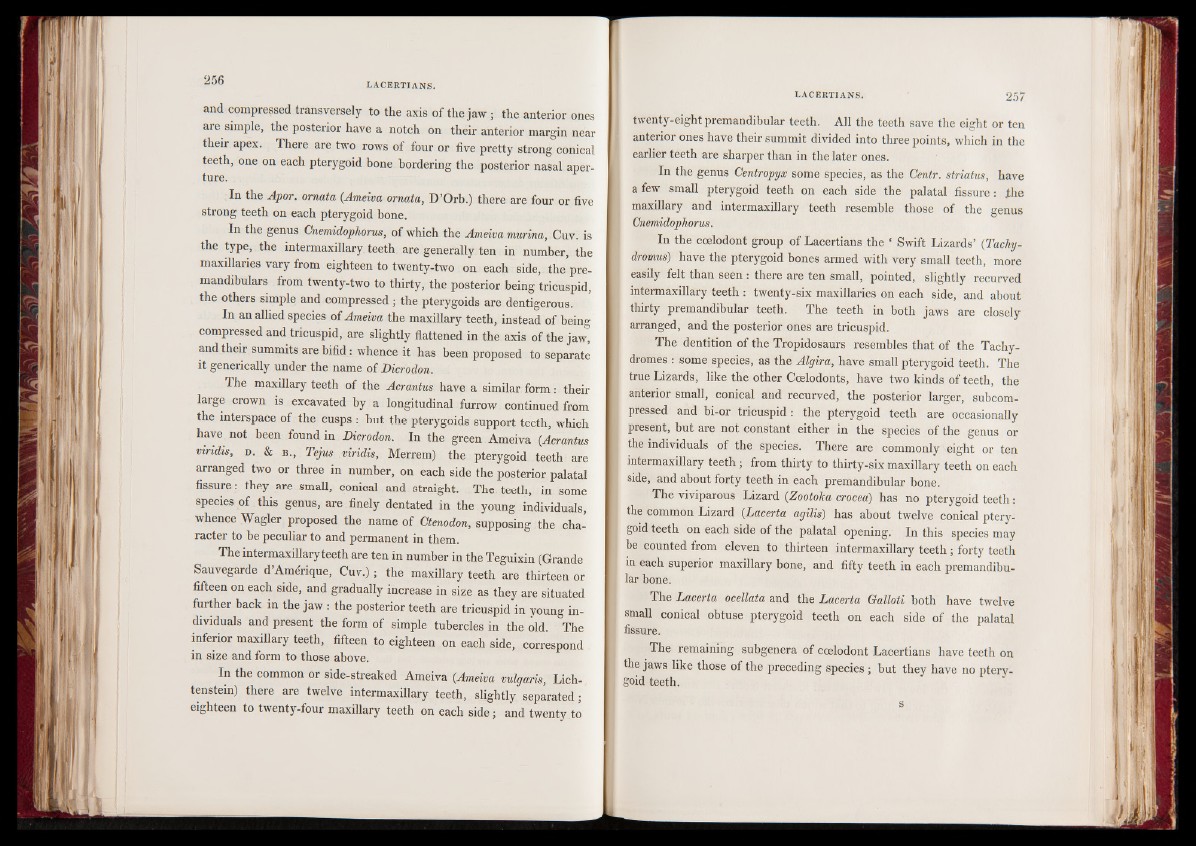
LACERTIANS.
and compressed transversely to the axis of the jaw ; the anterior ones
are simple, the posterior have a notch on their anterior margin near
their apex. There are two rows of four or five pretty strong conical
teeth, one on each pterygoid bone bordering the posterior nasal aperture.
. .
In the Apor. ornata (Ameiva ornata, D’Orb.) there are four or five
strong teeth on each pterygoid hone.
In the genus Cnemidophorus, of which the Ameiva murina, Cuv. is
the type, the intermaxillary teeth are generally ten in number, the
maxillaries vary from eighteen to twenty-two on each side, the pre-
mandibulars from twenty-two to thirty, the posterior being tricuspid,
the others simple and compressed ; the pterygoids are dentigerous.
In an allied species of Ameiva the maxillary teeth, instead of being
compressed and tricuspid, are slightly flattened in the axis of the jaw,
and their summits are bifid : whence it has been proposed to separate
it generically under the name of Dicrodon.
The maxillary teeth of the Acrantus have a similar form : their
large crown is excavated by a longitudinal furrow continued from
the interspace of the cusps : hut the pterygoids support teeth, which
have not been found in Dicrodon. In the green Ameiva (.Acrantus
viridis, d . & b ., Tejus viridis, Merrem) the pterygoid teeth are
arranged two or three in number, on each side the posterior palatal
fissure: they are small, conical and straight. The.teeth, in some
species of this genus, are finely dentated in the young individuals,
whence Wagler proposed the name of Ctenodon, supposing the character
to be peculiar to and permanent in them.
The intermaxillary teeth are ten in number in the Teguixin (Grande
Sauvegarde d’Amérique, Cuv.) ; the maxillary teeth are thirteen or
fifteen on each side, and gradually increase in size as they are situated
further back in the jaw : the posterior teeth are tricuspid in young individuals
and present the form of simple tubercles in the old. The
inferior maxillary teeth, fifteen to eighteen on each side, correspond
in size and form to those above.
In the common or side-streaked Ameiva (Ameiva vulgaris, Lichtenstein)
there are twelve intermaxillary teeth, slightly separated ;
eighteen to twenty-four maxillary teeth on each side; and twenty to
twenty-eight premandibular teeth. All the teeth save the eight or ten
anterior ones have their summit divided into three points, which in the
earlier teeth are sharper than in the later ones.
In the genus Centropyx some species, as the Centr. striatus, have
a few small pterygoid teeth on each side the palatal fissure : the
maxillary and intermaxillary teeth resemble those of the genus
Cnemidophorus.
In the ccelodont group of Lacertians the ‘ Swift Lizards’ (Tachy-
dromus) have the pterygoid bones armed with very small teeth, more
easily felt than seen : there are ten small, pointed, slightly recurved
intermaxillary teeth : twenty-six maxillaries on each side, and about
thirty premandibular teeth. The teeth in both jaws are closely
arranged, and the posterior ones are tricuspid.
The dentition of the Tropidosaurs resembles that of the Tachy-
dromes : some species, as the Algira, have small pterygoid teeth. The
true Lizards, like the other Ccelodonts, have two kinds of teeth, the
anterior small, conical and recurved, the posterior larger, subcompressed
and hi-or tricuspid : the pterygoid teeth are occasionally
present, hut are not constant either in the species of the genus or
the individuals of the species. There are commonly eight or ten
intermaxillary teeth; from thirty to thirty-six maxillary teeth on each
side, and about forty teeth in each premandibular bone.
The viviparous Lizard (Zootoika crocea) has no pterygoid teeth:
the common Lizard (Lacerta agilis) has about twelve conical pterygoid
teeth on each side of the palatal opening. In this species may
be counted from eleven to thirteen intermaxillary teeth; forty teeth
in each superior maxillary bone, and fifty teeth in each premandibular
bone.
The Lacerta ocellata and the Lacerta Galloti both have twelve
small conical obtuse pterygoid teeth on each side of the palatal
fissure.
The remaining suhgenera of ccelodont Lacertians have teeth on
the jaws like those of the preceding species ; but they have no pterygoid
teeth.
s